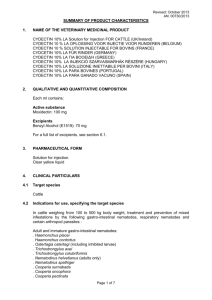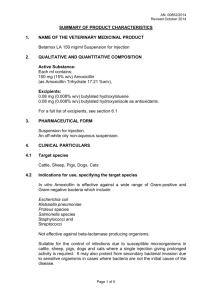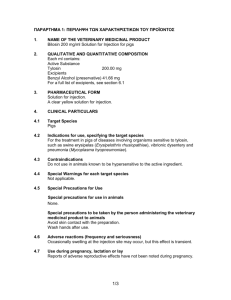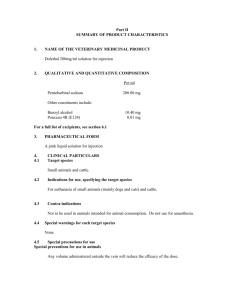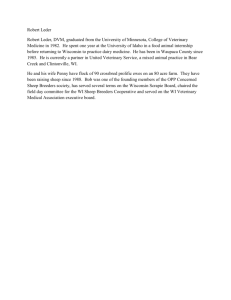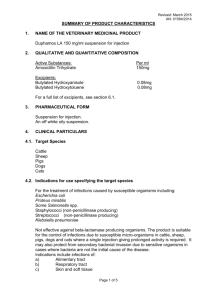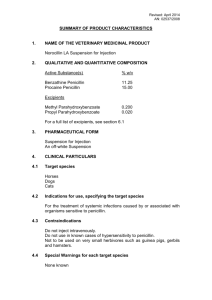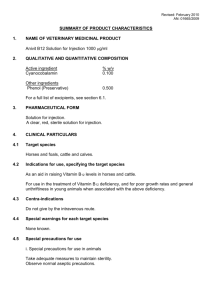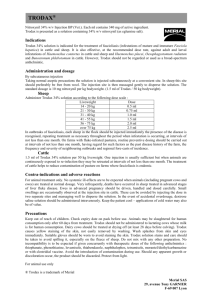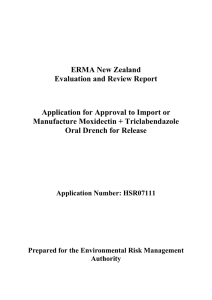summary of product characteristics
advertisement
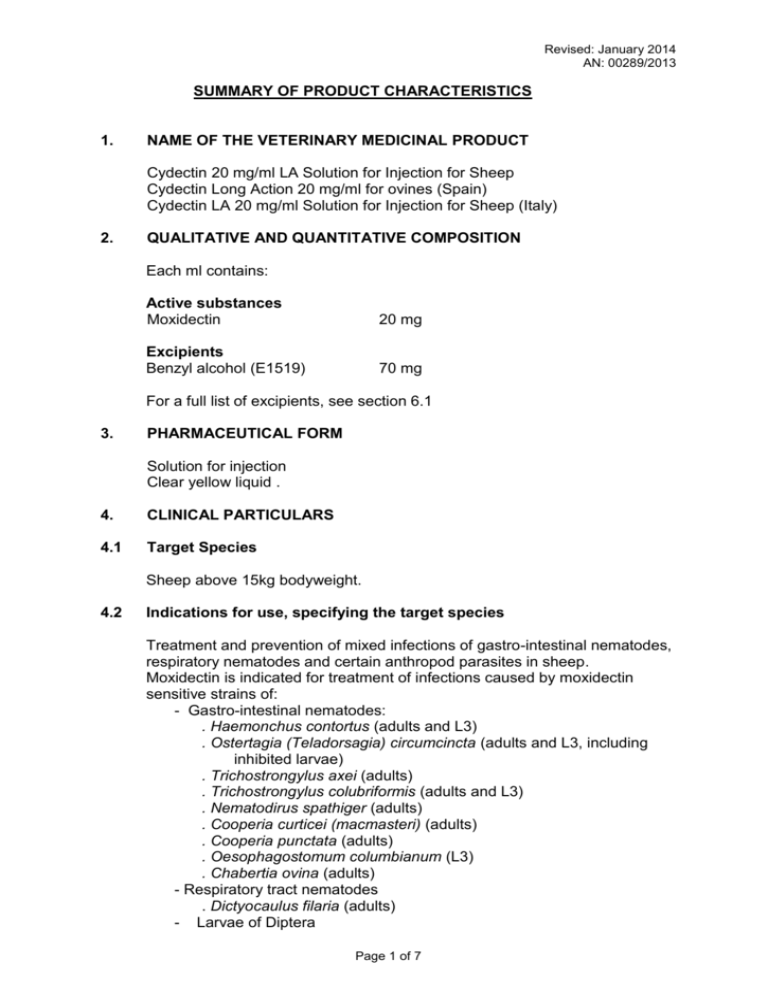
Revised: January 2014 AN: 00289/2013 SUMMARY OF PRODUCT CHARACTERISTICS 1. NAME OF THE VETERINARY MEDICINAL PRODUCT Cydectin 20 mg/ml LA Solution for Injection for Sheep Cydectin Long Action 20 mg/ml for ovines (Spain) Cydectin LA 20 mg/ml Solution for Injection for Sheep (Italy) 2. QUALITATIVE AND QUANTITATIVE COMPOSITION Each ml contains: Active substances Moxidectin 20 mg Excipients Benzyl alcohol (E1519) 70 mg For a full list of excipients, see section 6.1 3. PHARMACEUTICAL FORM Solution for injection Clear yellow liquid . 4. CLINICAL PARTICULARS 4.1 Target Species Sheep above 15kg bodyweight. 4.2 Indications for use, specifying the target species Treatment and prevention of mixed infections of gastro-intestinal nematodes, respiratory nematodes and certain anthropod parasites in sheep. Moxidectin is indicated for treatment of infections caused by moxidectin sensitive strains of: - Gastro-intestinal nematodes: . Haemonchus contortus (adults and L3) . Ostertagia (Teladorsagia) circumcincta (adults and L3, including inhibited larvae) . Trichostrongylus axei (adults) . Trichostrongylus colubriformis (adults and L3) . Nematodirus spathiger (adults) . Cooperia curticei (macmasteri) (adults) . Cooperia punctata (adults) . Oesophagostomum columbianum (L3) . Chabertia ovina (adults) - Respiratory tract nematodes . Dictyocaulus filaria (adults) - Larvae of Diptera Page 1 of 7 Revised: January 2014 AN: 00289/2013 . Oestrus ovis: L1, L2, L3 Mange mites . Psoroptes ovis Trials have shown that moxidectin is effective against certain strains of Haemonchus contortus, Teladorsagia circumcincta and Trichostrongylus spp. resistant to benzimidazoles. - The product has a persistent action and protects sheep against infection or re-infection with the following parasites for the period indicated: Species Days Ostertagia (Teladorsagia) circumcincta Haemonchus contortus Trichostrongylus colubriformis Psoroptes ovis 97 111 44 60 Persistent efficacy periods have not been established for parasite species other than those included in the list above. Therefore, re-infection of animals on pasture contaminated by parasites other than these remains possible before the 44 day minimum persistency period demonstrated for specific species. 4.3 Contraindications Do not use in sheep less than 15 kg bodyweight. Do not use in cases of hypersensitivity to the active substance or to any excipients. See also section 4.5 (i) 4.4 Special warnings for each target species Care should be taken to avoid the following practices because they increase the risk of development of resistance and could ultimately result in ineffective therapy: - Too frequent and repeated use of anthelmintics from the same class, over an extended period of time Underdosing, which may be due to underestimation of body weight, misadministration of the product, or lack of calibration of the dosing device (if any). Suspected clinical cases of resistance to anthelmintics should be further investigated using appropriate tests (e.g. Faecal Egg Count Reduction Test). Where the results of the test(s) strongly suggest resistance to a particular anthelmintic, an anthelmintic belonging to another pharmacological class and having a different mode of action should be used. Resistance to macrocyclic lactones has been reported in Teladorsagia in sheep in a number of countries. In 2008, throughout Europe, moxidectin resistance is very rare; it has been reported in a single case Page 2 of 7 Revised: January 2014 AN: 00289/2013 involving a levamisole-, benzimidazole and ivermectin-resistant strain of Teladorsagia circumcincta. Therefore the use of moxidectin should be based on local (regional, farm) epidemiological information about susceptibility of nematodes, local history of treatments and recommendations on how to use the product under sustainable conditions to limit further selection for resistance to anthelmintics. These precautions are especially important when moxidectin is being used to control resistant strains. 4.5 Special precautions for use i. Special precautions for use in animals This product has been formulated specifically for subcutaneous injection in the base of the ear of sheep and must not be given by any other route of administration or to any other species. ii. Special precautions to be taken by the person administering the veterinary medicinal product to animals Avoid direct contact with skin and eyes. Wash hands after use. Do not smoke, drink or eat while handling the product. Take care to avoid self-injection. If this occurs, it is unlikely that any product related symptoms will be observed. In case of accidental self injection, seek medical advice immediately and show the package leaflet or the label to the physician. Advice to Medical Practitioners in case of accidental self injection: Treat symptomatically. 4.6 Adverse reactions (frequency and seriousness) Swelling and inflammation may be found at the injection site in some animals following treatment. The swelling generally disappears within 7 days of treatment and generally resolves without any medical treatment required. In rare cases, adverse reactions such as transitory salivation, depression, drowsiness and ataxia might occur. No particular treatment is required; these symptoms usually disappear within 24 to 48 hours. There is no specific antidote. 4.7 Use during pregnancy, lactation or lay Can be used during pregnancy. However, note 4.3. Contraindications. 4.8 Interactions with other medicinal products and other forms of interaction The effects of GABA agonists are increased by moxidectin. Page 3 of 7 Revised: January 2014 AN: 00289/2013 4.9 Amounts to be administered and administration route Dosage is 0.5 ml/10 kg bodyweight to give 1 mg moxidectin/ kg bodyweight. The 50ml vial stoppers must not be broached more than 10 times. Use automatic syringe equipment for the 200 ml and 500ml vials. To ensure administration of a correct dose, bodyweight should be determined as accurately as possible; accuracy of the dosing device should be checked. If animals are to be treated collectively rather than individually, they should be grouped according to their bodyweight and dosed accordingly, in order to avoid under- or overdosing. The injection should be administered as a single subcutaneous injection at the base of the ear using an 18 gauge, 25 mm hypodermic needle. With the animal's head under control, the formulation should be administered about 2 cm caudal from the anterior (rostral) edge of the pinna at the base of the ear. The skin at the base of the selected ear should be pinched and the product injected into the subcutaneous tissue. Following subcutaneous administration, the needle should be withdrawn from the skin as pressure is applied with the thumb at the point of insertion for several seconds. If leakage occurs then pressure should be applied for several additional seconds. Diagram: Ear injection procedure 4.10 Overdose (symptoms, emergency procedures, antidotes), if necessary Signs of overdoses have not been seen at 3 and 5 times the recommended dose. However, if they do occur they should be consistent with the mode of action of moxidectin and would be manifested as transient salivation, depression, drowsiness and ataxia 24 to 36 hours post-treatment. The Page 4 of 7 Revised: January 2014 AN: 00289/2013 signs would usually disappear within 36 to 72 hours without treatment. There is no specific antidote. 4.11 Withdrawal period(s) Meat and offal: 104 days. Milk: Not permitted for use in dairy sheep, at any stage of life. The withdrawal period is based solely on a single injection at the base of the ear. 5. PHARMACOLOGICAL PROPERTIES Pharmacotherapeutic group: antiparasitic product, endectocide ATCvet Code: QP54AB02, moxidectin 5.1 Pharmacodynamic properties Moxidectin is an endectocide active against a wide range of internal and external parasites and is a second generation macrocyclic lactone of the milbemycin family. Moxidectin interacts with GABA receptors and chloride channels. The net effect is to open the chloride channels on the postsynaptic junction to allow the inflow of chloride ions and induce an irreversible resting state. This results in flaccid paralysis and eventual death of parasites exposed to the drug. The product has a persistent activity against the second instar larvae of Oestrus Ovis (L2 Larvae only) up to 80 days after treatment. However, re-infestation with 1st instar larvae is not prevented and clinical signs arising from such re-infestation may be observed during this period. 5.2 Pharmacokinetic particulars Moxidectin is absorbed following subcutaneous injection with maximum blood concentrations (Cmax 24 ng/ml) being achieved 4 to 7 days post injection. Mean AUC last is 411 ng.d/ml. The drug is distributed throughout the body tissues but due to its lipophilicity it is concentrated mainly in the fat. The depletion half life in fat is 30 - 34 days. Moxidectin undergoes biotransformation by hydroxylation in the body. The only significant route of excretion is the faeces. 6. PHARMACEUTICAL PARTICULARS 6.1 List of excipients Benzyl Alcohol (E1519) Sorbitan Oleate Propylene glycol dicaprylocaprate Page 5 of 7 Revised: January 2014 AN: 00289/2013 6.2 Incompatibilities In the absence of compatibility studies, this veterinary medicinal product must not be mixed with other veterinary medicinal products. 6.3 Shelf life Shelf life of the veterinary medicinal product as packaged for sale: 3 years. Shelf life after first opening the immediate packaging: 28 days. 6.4 Special precautions for storage Do not store above 25°C. Keep the container in the outer carton in order to protect from light. 6.5 Nature and composition of immediate packaging Natural high density polyethylene vials with chlorinated butyl rubber stoppers and aluminium flip off seals (50 ml) or aluminium seals (200 ml, 500ml). Each vial is supplied in a carton. Not all pack sizes may be marketed 6.6 Special precautions for the disposal of unused veterinary medicinal product or waste materials derived from the use of such products EXTREMELY DANGEROUS FOR FISH AND AQUATIC ORGANISMS. Do not contaminate ponds, waterways or ditches with the product or empty container. Any unused veterinary medicinal product or waste materials derived from such veterinary medicinal products should be disposed of in accordance with local requirements. Page 6 of 7 Revised: January 2014 AN: 00289/2013 7. MARKETING AUTHORISATION HOLDER Zoetis UK Limited 5th Floor, 6 St. Andrew Street London EC4A 3AE 8. MARKETING AUTHORISATION NUMBER Vm 42058/4029 9. DATE OF FIRST AUTHORISATION Date: 13 January 2009 10. DATE OF REVISION OF THE TEXT Date: January 2014 Approved: Page 7 of 7 08/01/2014
